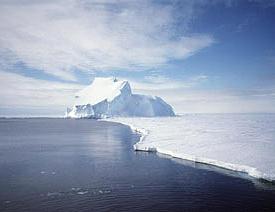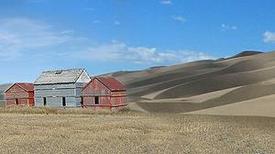 美國聯邦政府已決定正視突發性氣候變遷所構成之威脅。由6個國家級實驗室科學家分派所組成的新計畫案,將試圖界定突發性氣候變遷之可能機制,以建立綜合性電腦模型,並在突發性氣候變遷現象發生前,作精準的預測。
美國聯邦政府已決定正視突發性氣候變遷所構成之威脅。由6個國家級實驗室科學家分派所組成的新計畫案,將試圖界定突發性氣候變遷之可能機制,以建立綜合性電腦模型,並在突發性氣候變遷現象發生前,作精準的預測。
多數人均認為氣候變遷是逐漸發生的現象,主要源自化石燃料的燃燒造成大氣中二氧化碳的累積,或是普遍性的土地使用變化所形成的作用力等,造成一百年來甚至更久以來平均溫度上升攝氏1-2度。不過科學家警告,全球溫度上升攝氏10度,也不是不可能。
服務於勞倫斯柏克萊國家實驗室(The Lawrence Berkeley National Lab)地球科學部門,並將帶領此計劃案的克林斯(William Collins)表示,「突發性氣候變遷有許多別名,如惡作劇、鬼牌、臨界點等。」
克林斯將協調來自6個實驗室所組成的「IMPACTS科學研究團隊」(突發性氣候轉變之量值與或然性調查,Investigation of the Magnitudes and Probabilities of Abrupt Climate Transitions)。此計劃案將聯合各領域專家,包含鑽研氣候過程之物理、化學、生物地質化學層面的專家,以及建構整個地球系統的電腦模型專家。「當國家實驗室參與者首度會面,在決定對突發性氣候變遷之最重要潛在資源時,釐清定義為首當之要。」克林斯表示。
所謂「突發性氣候變遷」,科學家普遍同意的定義為:「比作用機制(forcing mechanisms)所帶來的效應還快速產生的大幅度變遷,以數年到數十年,而非百年為尺度,並長久持續發生。」
身為勞倫斯柏克萊國家實驗室氣候科學部門領導的克林斯,曾協調「社群氣候系統模型」(Community Climate System Model)最新版本之發展──2007年與美國前副總統高爾(Al Gore)同獲諾貝爾和平獎的「政府間氣候變遷委員會」(IPCC),就使用了這套重要模型,作為其評估氣候變遷的物理學基礎之一。
「IMPACTS」計劃將以此電腦模型為基礎,增加新的性能和診斷,來偵測可能啟動突發性氣候變遷的進程。參與此計劃的國家實驗室,包括了阿岡(Argonne)、洛斯阿拉莫(Los Alamos)、勞倫斯柏克萊(Lawrence Berkeley)、勞倫斯利物慕(Lawrence Livermore)、橡樹嶺(Oak Ridge)與西北太平洋(Pacific Northwest)等實驗室。
克林斯表示:「IMPACTS為研究突發性氣候變遷兩端途徑之一,研究途徑分別為大學和國家實驗室,兩者將會分享一個中樞入網口,而所有參與者則會每年度集會一次。」
IMPACTS 團隊將聚焦於四種突發性氣候變遷型態。克林斯半開玩笑地稱呼這些為「啟示錄的四騎士。」(編註:四騎士為:瘟疫、戰爭、飢荒和死亡。)這四種型態分別是:
型態一:海洋大冰原,特別是西南極大冰原的不穩定。
 近40年來,科學家一直擔心全球暖化終究造成西南極大冰原近380萬立方公里的冰之斷裂、滑落入海洋之後果。
近40年來,科學家一直擔心全球暖化終究造成西南極大冰原近380萬立方公里的冰之斷裂、滑落入海洋之後果。
在 2006年1月,由英國政府所委任的調查報告中,英國南極勘測(The British Antarctic Survey)負責人瑞柏利(Chris Rapley)曾指出,幅員廣大的西南極大冰原可能開始瓦解。美國國家太空暨航空總署(NASA)資深科學家漢森(James Hansen)表示,瑞伯利的研究報告令人憂心,「一旦一片冰原開始瓦解,可在到達一個臨界點後猛爆性地急速斷裂。」
若此型態發生,海平面會上升6公尺,世界各地海港設施將被淹沒,環礁島嶼和島嶼群島將會消失;部分孟加拉,緬甸,美國南方靠海灣的州(註:德州、密西西比、路易斯安那、阿拉巴馬及佛羅里達州),及其他低漥地帶可能淹沒;威尼斯、紐奧良和許多其他城市將會沉沒。
很明顯地,這些事件並不是「最終結果」。突發性氣候變遷可導致冰山急速融化,以及隨後海平面以每世紀幾公尺而非幾公分的上升。
型態二:亞北極森林和北極生態系統的「正反饋機制」,造成甲烷迅速排出或地表能量平衡大幅度改變。
地球陸地1/3以上的有機碳集中於緯線45度以北的生態系統內,大多存在土壤、泥炭地盆地和永凍帶。生態系統和陸地生態系統、氣候、洋流中的「正反饋」(positive feedback)機制,將快速釋放大量儲存的碳進入大氣中。
因 為冰山融化帶來的「正反饋」,已加速了極北地區的全球暖化步伐。現在看來,原本僅可在20到30年間發生的陸地生態系統變遷,可能變本加厲在北極甚至是全 球地區加速發生,變遷速度可能是原本預測的2到3倍。 (編註:正反饋,增強大氣因二氧化碳濃度增加而產生的暖化效應。)
型態三:甲烷水合物(大量儲存在水冰中的甲烷氣體)趨於不穩定,尤其是在北極海域。
 地球上極大量的碳,儲存在海底冰凍的甲烷水合物裡──很可能還超過所有可開採的化石燃料。甲烷氣體分子以高濃縮形式被鎖在水冰裡,其濃縮量高到當冰溶化時,氣體的體積可擴張到冰凍時固體體積的164倍高。
地球上極大量的碳,儲存在海底冰凍的甲烷水合物裡──很可能還超過所有可開採的化石燃料。甲烷氣體分子以高濃縮形式被鎖在水冰裡,其濃縮量高到當冰溶化時,氣體的體積可擴張到冰凍時固體體積的164倍高。
一 般來說,即便大氣明顯暖化,高壓及低溫環境仍可確保大多數深海甲烷的穩定性。然而在北極,甲烷水合物儲存環境的氣溫與壓力,已接近安全邊緣,在這些地點, 甲烷可能突發性釋放,造成氣候急速暖化;暖化再進一步引發更多甲烷釋放,結果會是:永凍帶融化,深海成死亡地帶,北極上空的臭氧層破洞會擴大並更常發生。
型態四:生物圈和大氣間的反饋,可能導致北美洲大乾旱。
 由 「政府間氣候變遷委員會」(IPCC)所預測的溫室效應,將會造成墨西哥及美國西南部等亞熱帶地區更炎熱、更乾燥的環境狀態。除了空氣和海平面溫度上升之 外,還有其他效應:風暴路徑可能往北轉移,噴射氣流將有可能穩定成新的結構。乾掉的土壤和乾熱的大氣互動,可能啟動突發性氣候變遷。
由 「政府間氣候變遷委員會」(IPCC)所預測的溫室效應,將會造成墨西哥及美國西南部等亞熱帶地區更炎熱、更乾燥的環境狀態。除了空氣和海平面溫度上升之 外,還有其他效應:風暴路徑可能往北轉移,噴射氣流將有可能穩定成新的結構。乾掉的土壤和乾熱的大氣互動,可能啟動突發性氣候變遷。
如果乾掉的土壤和乾熱的大氣互動,並在西南部導致突發性氣候變遷,一百年前侵害北美洲的大乾旱可能再復出。
此外,如同1930年代美國中部所發生的塵暴也會復出,並持續個十來年──1930年代的塵暴,將曾經肥沃多產的土地和畜牧地轉變成移動的沙丘。那之前曾經更慘烈,有龐大沙堆游移橫跨高原。
因為有更進步的科學、更精密的模型、以及效力更強大的電腦──像能源部國家能源研究科學計算中心(National Energy Research Scientific Computing Center)的電腦,直到最近,科學家才有辦法建立綜合性的氣候模型。
克林斯認為,IMPACTS計畫最大的益處之一,在於結合往常相互溝通匱乏的氣候研究社群。他說,對於關注氣候變遷以及氣候模擬的科學家們,「工作關係尚未出現。全球暖化對人類健康最嚴重的威脅中,最糟的是營養不足,但是次要糟的是極端氣候!」
克林斯說,針對一個特定地區和特定的情況環境做預報,以高分辨率來為往後幾十年作紮實的預測,這比上預報整個地球往後一百年的發展難度高很多。他表示:「關注氣候變遷效應對人類之影響的人,從未邀請模擬專家來做這件事,我們希望IMPACTS將可證明這跨領域合作的可行性。」
Abrupt and rapid climate change is a threat that the federal government has just decided to take seriously. Scientists from six national laboratories have been assigned to a new project that will undertake to define possible mechanisms of abrupt climate change well enough to build comprehensive computer models and make accurate predictions before the climate changes abruptly.
Most people think of climate change as something that occurs gradually, with average temperatures rising two or three degrees Celsius over a century or longer due to forcing mechanisms such as the accumulation of carbon dioxide in the atmosphere from the burning of fossil fuels or widespread changes in land use. But a 10 degree Celsius rise in global temperatures is not unlikely, the scientists warn.
"There are lots of names for abrupt climate change - nasty surprises, the jokers in the deck, the tipping point," says William Collins of the Lawrence Berkeley National Lab Earth Sciences Division, who will head the project.
Collins will coordinate the work of scientists from the six labs under the name IMPACTS, which stands for Investigation of the Magnitudes and Probabilities of Abrupt Climate Transitions. The program will bring together the work of experts in physical, chemical, and biogeochemical climate processes and in computer simulations of the whole Earth system.
"When the national lab participants first met to decide on the most significant potential sources of abrupt climate change in future, the first thing we had to do was define what we meant," Collins said.
The scientists agreed that abrupt climate change means "a large-scale change that happens more quickly than that brought on by forcing mechanisms - on a scale of years to decades, not centuries - and that persists for a very long time."
Collins, who heads the Climate Science Department in the Berkeley Lab's Earth Sciences Division, coordinated the development of the most recent version of the Community Climate System Model, one of the leading computer models underpinning the physical science basis of the 2007 climate change assessment conducted by the Intergovernental Panel on Climate Change, which shared the Nobel Peace Prize with former U.S. Vice President Al Gore.
The IMPACTS program will be based on this computer model and will add new capabilities and new diagnostics for processes that could initiate abrupt climate change.
Argonne, Los Alamos, Lawrence Berkeley, Lawrence Livermore, Oak Ridge, and Pacific Northwest are the participating national laboratories.
"IMPACTS is one part of a two-pronged approach to studying abrupt climate change, one based in the universities and the other in the national labs," says Collins. "Both elements will share a central web-based portal, with all the participants meeting annually."
The IMPACTS team will initially focus on four types of abrupt climate change. Only half joking, Collins refers to these as "The Four Horsemen of the Apocalypse."
1. Instability among marine ice sheets, particularly the West Antarctic ice sheet
For 40 years earth scientists have worried about what would happen if global warming eventually caused the West Antarctic ice sheet, some 3.8 million cubic kilometers of ice, to break up and slide into the ocean. In January 2006, in a report commissioned by the UK government, the head of the British Antarctic Survey, Chris Rapley, warned that this huge west Antarctic ice sheet may be starting to disintegrate.
James Hansen, a senior NASA scientist, said the results of Rapley's study were deeply worrying. "Once a sheet starts to disintegrate, it can reach a tipping point beyond which break-up is explosively rapid," he said.
Sea level would rise four to six meters - 13 to 20 feet. Port facilities worldwide would be submerged; atolls and island chains would vanish; parts of Bangladesh, Brazil, Burma, America's Gulf States, and other low-lying areas would flood; Venice, New Orleans, and many other cities would sink.
It is now apparent that these events may not be "eventual." Abrupt climate change could cause rapid melting and the subsequent rise of sea level not by centimeters but by meters per century.
2. Positive feedback mechanisms in subarctic forests and arctic ecosystems, leading to rapid methane release or large-scale changes in the surface energy balance
More than a third of Earth's terrestrial organic carbon is concentrated in the ecosystems north of the 45th parallel, much of it in soil, peatland basins, and permafrost. Positive feedback within ecosystems and among terrestrial ecosystems, climate, and ocean currents could rapidly release much of this stored carbon into the atmosphere.
Positive feedback involving ice-melt has already accelerated the pace of global warming in the far north. It now seems likely that changes in terrestrial ecosystems, which could occur over only 20-30 years, may amplify currently predicted global warming by two or three times, in the Arctic and possibly globally.
3. Destabilization of methane hydrates - vast deposits of methane gas caged in water ice - particularly in the Arctic Ocean
A vast quantity of carbon - possibly more than all the recoverable fossil fuels on Earth - is trapped in frozen methane hydrates under the oceans. Methane gas molecules are locked inside cages of water ice in a form so concentrated that when the ice melts the gas expands to 164 times its frozen volume.
High pressure and low temperature insure that most deep-water methane hydrate deposits would be stable even with considerable warming of the atmosphere.
But in the Arctic, methane hydrate deposits exist near the edge of the safe temperature-pressure zone; in these locales, methane release could be abrupt. The resultant rapid warming would trigger yet more releases of methane: permafrost would melt, the deep sea would become a dead zone, the hole in the Arctic ozone would grow bigger and occur more frequently.
4 Feedback between biosphere and atmosphere that could lead to megadroughts in North America
Ordinary greenhouse warming as forecast by the IPCC will result in warmer and dryer conditions in the subtropics, including Mexico and the southwestern U.S. More than warming of the air and sea surface are involved. Storm tracks are likely to shift north, and the jet stream will probably stabilize in a new configuration. Dried-out soil and hot, dry atmosphere could interact to start abrupt climate change.
If dried-out soil and hot, dry atmosphere interact to trigger abrupt climate change in the Southwest, megadroughts like those that plagued North America a millemium ago could quickly return.
Conditions as severe as the Dust Bowl of the 1930s will return and could persist for decades: a megadrought. The Dust Bowl of the thirties turned many once productive fields and rangelands into shifting sand dunes. The past was even worse, with vast sheets of sand on the move all across the High Plains.
Better science, more sophisticated models, and more powerful computers like those at the Department of Energy's National Energy Research Scientific Computing Center have only recently made it possible to build comprehensive climate models.
One of the great benefits of IMPACTS, in Collins's view, will be to bring together parts of the climate community whose communication has traditionally been poor.
For scientists concerned with the effects of climate change and those concerned with modeling it, "the working relationship hasn't been there," he says. "For example, of the major threats to human health from global warming, the worst is malnutrition - but the second worst is extreme weather!"
Collins says modeling a specific region with a specific set of circumstances in high resolution and making a solid prediction for the next few decades is much tougher than modeling what will happen to the whole planet a century from now.
"Those concerned with the effects of climate change on humans have never asked modelers to do this before," he says. "We hope that IMPACTS will demonstrate that it can be done."







